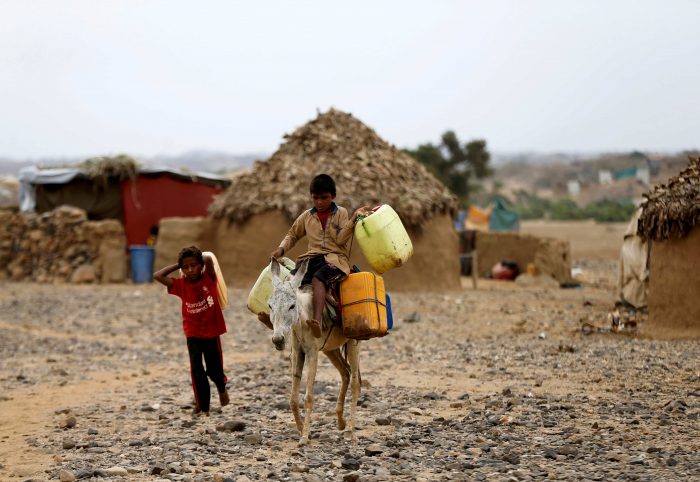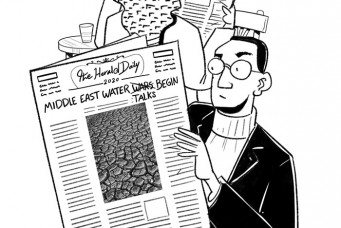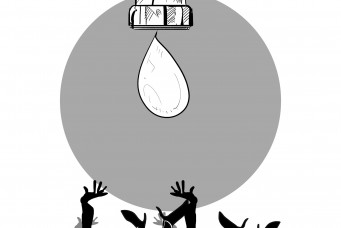Averting a Total Collapse
How is the water-energy-food nexus impacting ecological, social, and political systems in the Middle East and North Africa?

Two boys transport water jerry cans in a camp for internally displaced people near Abs of the northwestern province of Hajja, Yemen, Feb. 18, 2019. Reuters/ Khaled Abdullah
The relationship, or nexus, between water, energy, and food is the most fragile in the Middle East and North Africa (MENA). Water resources are being depleted rapidly; energy resources are becoming limited in many nations; and food production is dropping, with many nations importing most of their basic food. Most troubling is that water insecurity leads to social, and therefore political, instability. As a result of major droughts and mismanagement, Somalia became the first nation in the region to experience a total “nexus collapse,” leading to civil war and dysfunctional government and social structures. Yemen, once a breadbasket of the Middle East, has descended into civil war and societal collapse; it now imports most of its basic foods and has approximately ten years of water and energy reserves left. Syria experienced civil war as droughts destroyed agriculture and displaced populations to urban centers, and Jordan is projected to be the next failed nexus state.
The nexus was proposed in the early twenty-first century as a framework for integrating the three factors controlling the structure and function of human communities and ecosystems globally: water, energy, and food (WEF). Together, these influence human health and in turn are driven by economics, the ultimate factor in policy development. Balancing such interactive resources is necessary to maintain community and national stability in the face of declining resources and increased demands associated with changing human demographics, land use, and climate.
In MENA especially, there is a critical need to understand the factors that govern the functions of water, energy, and food individually as well as the myriad of complex interactions among them. The ability to identify what causes a nexus imbalance, including population dynamics and climate change, and whether they cause the three-legged stool to wobble or totally collapse, is still in its infancy and needs to be tailored to the conditions in individual states. No one model fits all situations, but looking at tipping points and the role of adaptive management to alter practices that might prove fatal is required.
Factors Affecting the WEF Nexus
It is impossible to identify a single overarching factor responsible for destabilizing the water-energy-food balance in the MENA region. Individual factors vary greatly across the region, but in general, the causes can be attributed to a combination of issues such as climate change, diminishing water resources in the face of increased demands, unsustainable land management, and changing human demographics.
The consequences of climate change in MENA are evident, and the future looks dire. By 2080, North African countries on the Mediterranean coast will get 40 percent less rainfall, while the Sahel, which has experienced near continuous droughts since the 1970s, is expected to get even drier. Farmers dependent on certain annual rainfall patterns are reluctant to start farming during periods of rainfall unpredictability, thus potentially losing the window for crop production for a given year. Few possess the resources to shield against a bad year, and thus many must resort to unsustainable practices to support the immediate needs of their families. Although there is no other option for survival, skipping a farming season risks desertification and long-term food insecurity. But short-term climate uncertainty is more difficult to forecast and plan for than the long-term impact of climate change.
All throughout the region, water resources are critically low. Major aquifers have been over-pumped to the point that there is little remaining water. Agriculture utilizes the most water in the majority of MENA nations, and is no longer cost-effective. Springs, the only water supply available to local rural communities, have rapidly emptied over the past twenty years especially in Saudi Arabia’s eastern provinces and, to a lesser extent, in Oman and Jordan as a direct result of agricultural irrigation. Oman too has abandoned its traditional terraced agriculture systems in favor of “modern” high usage irrigation methods, while at the same time shifting from foodstuffs to the narcotic qat, mainly for local consumption. Saudi Arabia was, until the turn of the century, the sixth largest exporter of wheat and almost exclusively depended on groundwater resources, but abandoned such large-scale agricultural plans after its local and regional aquifers were exhausted.
As a consequence, water insecurity has led to abandonment of agriculture in rural areas as people moved to larger metropolitan areas or emigrated to coastal areas and beyond, thus destabilizing already severely stressed urban infrastructure with rapidly increasing populations. Per capita water use has increased quickly in such countries as Egypt, whose water demand exceeds its availability by 20 percent, and Jordan, which is pumping approximately twenty years’ worth of groundwater annually. Although a somewhat controversial claim, it has been suggested that water insecurity and droughts led Syrians to abandon their rural lands and move to metropolitan areas, resulting in economic and social instability and civil war. Similar reasoning has been applied to Somalia.
Arab nations are often trapped in water-intensive practices from which it is difficult to divest socially and economically. For example, the United Arab Emirates (UAE), which began to use groundwater in the 1970s to green and irrigate its forests, has overexploited its reserves and the longstanding irrigation practice is no longer sustainable. The country is now faced with the need to protect animal and plant life within the forests in order to avoid a public outcry. As bad practices such as these persist in the UAE and other nations, rapidly expanding urban centers should rely on desalination almost exclusively to meet domestic water demands. For example, water resources in Saudi Arabia come almost entirely from desalination plants, but most nations lack the energy resources to consider this alternative.
But what can tip the balance and cause everything to topple over? Two issues can drive tipping-point scenarios: the urban–rural disconnect and the demands of urbanization that are decreasing the benefits that flow between cities and their surrounding natural environment.
Tipping point one: the urban–rural disconnect
There is an expanding disconnect between rural food production and urban consumption. Not only are rural populations aging as youth move to cities seeking employment, but agricultural production is also plagued by insufficient water resources, droughts, and general climate unpredictability. The latter is especially serious, as farmers normally plant only when seasonal rains begin, and any delay in their arrival pushes the farming season later and compresses the season in which plants and crops grow. Loss of even a single annual crop is often sufficient to accelerate rural poverty and force the desertion of individual family farms, further increasing marginalization and the exodus to urban areas.
Urban sprawl is accelerating in these countries and ranges from irregular communities around Cairo, which are provided with limited services, to the highly structured types of development found in Muscat and other Gulf cities, where infrastructure is factored in as each new community moves in. Regardless of the mode of development, urban sprawl has increased the physical distance between the rural production and urban consumption of food and water significantly, adding to the woes of rural communities as the transport of products to urban markets becomes prohibitively expensive. Increased distance also promotes instability in urban populations as basic commodities are either hard to obtain or expensive. Increasingly, a rift is growing between the services that flow to cities and the few benefits that flow back to rural areas.
In order to meet the challenges of an imbalanced flow, urban populations must develop means of producing basic foodstuffs at the family or neighborhood level. Alongside that, programs must be implemented to empower rural populations, identify new approaches to agriculture production, and provide incentives for youth to remain on the land and use it sustainably. The High Atlas Foundation in Morocco takes an innovative approach to the issues facing rural populations. A critical component of this project is the development of value-added products for local and international markets. Empowerment of women via cooperatives for product development has been particularly successful and returns desperately needed funds to the community for schools and other services. The High Atlas Foundation has demonstrated how community ownership and empowerment help stabilize local rural economies and provide incentives for youth to obtain training, while reducing emigration to cities. Focusing on products with increased shelf life and added value has reduced barriers imposed by increased distances to urban markets and lessened the disparity in the flow between urban and rural populations.
Tipping point two: the urban biome
The earth is divided into biomes, geographical areas of comparable physical environment and climate with distinct plants and animals adapted to the same set of conditions. In the Middle East and North Africa, biomes are deserts, Mediterranean coastal areas, or mountains. Numerous studies have documented the general principles governing the structure and function of individual biomes and the specific ecosystems therein. Biomes are not static in time or space, as evidenced by the expansion of the Sahara Desert into the Sahel of West Africa in response to climate change and shifting human demographics. The extensive database on individual biomes has proven extremely valuable in projecting responses of biomes to catastrophic and long-term changes in climate and resources affecting the WEF in rural areas.
Increasingly, natural and social scientists have suggested that metropolitan areas be considered anthropogenic (urban) biomes, with a comparable suite of structures, functions, and processes as any natural biome. In reality, urban biomes are embedded within natural biomes and depend on the latter to supply water, food, and energy sustainably. In turn, the surrounding natural biome is subject to harm and damage from the urban biome such as air and water pollution, solid wastes, and contaminants that can accumulate within natural ecosystems and lead to the loss of important species. Increasingly, urban sprawl is hindering the supply of water, energy, and food to meet the needs of the urban biome, while dramatically increasing the negative flow of wastes into the surrounding natural biome. Exponentially increasing demands for WEF resources to support burgeoning urban centers by necessity presents a dilemma for both farmers and rural land managers: whether to maintain sustainable management practices that are unable to meet urban demands, or take measures to maximize short-term yield while risking long-term instability for both rural and urban populations. Shortages of food and water have already caused community unrest in some parts of the world.
Adaptive Management and Nature-Based Solutions
While urban areas face climate and water supply problems, there is a critical need within cities to increase water-use efficiency to meet domestic demands. The MENA region is experiencing a massive increase in per capita water use, and an estimated 40 percent of domestic water in Cairo is lost to leakage before it reaches its intended user, while only 15 percent of wastewater is reused. As with any recyclable, water must be reused for multiple purposes and not be considered a single-use commodity to be discharged untreated. Conventional engineering approaches to gray infrastructure such as dams and water treatment plants have not been able to keep pace with increasing urban demands because of planning and cost constraints and the relatively short life expectancy of engineered solutions.
Green infrastructure, i.e. nature-based solutions that utilize ecosystems or their processes, have been implemented globally to supplement gray infrastructure or to replace it with efficient and cost-effective solutions. Such solutions stress storage and treatment of water in decentralized systems that, in turn, can be used for multiple communal purposes including passive recreation, community agriculture, and product development. Any water discharged from urban centers is wasted potential for promoting human sustainability and ecosystem health in downstream countries.
The concept of smart cities is rapidly gaining acceptance and being implemented globally. Connected infrastructure and the use of smart devices including cell phones to adapt resources to the real time needs of citizens are basic tenets of this movement. Nature-based solutions must be recognized as essential components of any smart city concept within the region, especially as the poor are falling further behind in technological advances, are chronically underserved by basic services of the WEF nexus, and are often the major group contributing to urban sprawl. While providing great resilience through technology, such solutions when applied to major urban cities in the developing world may be hindered by the rapid and irregular development of slums and unplanned housing (making it difficult to provide proper infrastructure). This is worsened by the increased demands for training and upgrading smart city applications.
Recognizing both the rapidly increasing distance between WEF resources of the natural biome and sprawling urban areas as well as the aging and often total failure of old centralized infrastructure, a number of measures are being implemented to meet the WEF demands of local neighborhoods and communities to provide quality, cost-effective services. Globally, wastewater is treated in constructed wetlands within the urban core, then stored for additional purposes. In turn, the wetlands provide a major community service as passive recreational sites. Maximizing multipurpose use is a clearly stated goal of most nature-based solutions. Many systems separate black water for treatment in constructed wetlands from gray water that can be used for irrigating rooftop or community gardens. This practice has been highly successful in Mexico City, where rooftop gardens now provide over 30 percent of the food consumed.
One readily available source of urban water—stormwater—is often overlooked, especially in the Middle East. Meanwhile, biofuels from organic waste have made major advances recently and have created a potential for supplying much of the cooking needs of poor communities while significantly reducing the demands of solid waste processing and storage. Finally, solar farms are gaining currency throughout the region, but rooftop solar generation has received little attention.
The WEF Nexus and Social Sustainability
Humans are an integral part of the WEF nexus, both influencing and being influenced by the quantity and quality of water, energy, and food and how they interact. At long last, people are considered part of the global ecology and not just recipients of nature’s benefits. Long-term sustainability of the WEF nexus in MENA can only be achieved if social, public health, economic, and political issues are brought to the forefront of planning and sound adaptive management scenarios are implemented in the face of climate change and the diminishing quantity and quality of natural resources.
Communities must take ownership of WEF nexus management. It is important that government authorities first meet with local communities to gauge concerns about the WEF, from which potential management scenarios can be developed and presented to the public for input, modification, and finally, acceptance. The public can serve as sentinels who provide continuous evaluation of the WEF nexus and can alert authorities at the early stages of imbalance. Such an early warning system will ensure the best approach to develop cost-effective adaptive management actions that lead to long-term sustainability.
Economic and public health concerns are foremost in the minds of local communities. The High Atlas Foundation in Morocco has numerous programs to empower local communities, including women’s cooperatives to develop natural products to supplement local economies, provide schooling and employment for youth, and reduce the exodus to urban centers. Their massive reforestation programs provide erosion protection to watersheds, conserve water resources, and provide carbon credits to Morocco. A major effort has been placed on conservation and cultivation of ancient varieties of nut and fruit trees that would otherwise disappear in the near future.
Water security ultimately drives the WEF nexus in MENA. Faced with increased distance to water resources associated with urban sprawl, escalating inability to pay for potable water, and contamination of available water sources with wastewater, the poor are particularly vulnerable to chronic water shortages and public health problems. Major water-borne diseases such as cholera and schistosomiasis are on the rise throughout MENA, and malaria has become a problem in conflict zones where mosquito eradication programs have been suspended. Green infrastructure in general, and nature-based solutions in particular, can provide resilience for urban populations to reduce water and air pollution, thus improving public health while meeting challenges to maintain a balanced WEF.
Climate change also poses major challenges to the sustainability of both natural and urban biomes. With agriculture currently accounting for over 80 percent of water use in many nations of the region, water resources in the surrounding natural biome will be insufficient to support the WEF needs of the urban biome, and residents will be forced to rely on maximizing resources within urban areas. Every drop of available water must be used, treated, and reused.
Ultimately, WEF insecurity leads to social insecurity and the displacement of the poor to sprawling urban areas. Eventually, it will lead to political unrest. It has been widely suggested that climate-related droughts, overuse of water resources, and reluctance to abandon agriculture in marginal areas or shift from unsuitable crops like wheat and qat have contributed significantly to the current political unrest in parts of MENA. Predictions of the tipping points for individual components of the WEF nexus, economic stability, and public health problems that set in motion social and political unrest are still in their infancy, however. Stability in MENA is linked to an ability to predict which nations are in danger of collapse and to assist them in adaptive management of the challenges at hand.
Thomas L. Crisman is Professor Emeritus and Jefferson Science Fellow at the University of South Florida, and a nonresident global fellow at the University of Central Florida. His research focuses on tropical aquatic ecology and water security issues of the Caribbean and MENA. He has delivered over 300 presentations and authored 100 papers, twenty-nine book chapters, and two books.
Read MoreSubscribe to Our Newsletter





